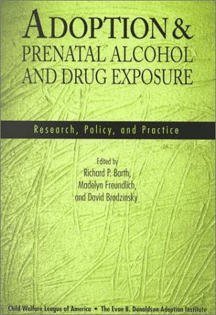Child Welfare League of Amer; 2000
Buy Adoption & Prenatal Alcohol and Drug Exposure: Research, Policy, and Practice on Amazon.com >
If I adopt a baby whose mother may have been using drugs or alcohol during the pregnancy, what issues might I expect for my child? Are there any differences if the infant has been exposed to alcohol versus drugs or both? Am I looking at serious medical, behavioral or emotional problems? Will my child require specialized educational services? Will he grow to be an independent and productive adult? Will she be at risk for drug or alcohol use herself? Will I be happy raising this child? Do I have the resources necessary to provide the best for this baby over time?
Any prospective parent facing these questions will find a morass of conflicting data: On the one hand, you may read that all such children are seriously and permanently damaged. On the other side, it is said that the issues of drug-exposed infants can be resolved with appropriate services. Or you may read that children prenatally exposed to alcohol are at such high risk for socially deviant behavior that adoption subsidies cover only a tiny portion of the needed services.
At last there is a resource that pulls together all the known information and interprets it in the light of adoption practice. This book, published by the Child Welfare League of America and the Evan B. Donaldson Adoption Institute, supported by the Robert Wood Johnson Foundation, draws on the knowledge of national and international experts in the fields of prenatal substance exposure and adoption.
The research section addresses what happens in three types of adoptive families: those with children who were exposed to drugs, those with children who were exposed to alcohol, and those with substance-exposed children who are being raised by relatives. Although each author focuses on his or her own research, all evaluate other studies so that the reader gets a full picture of the data available. I came away from this section understanding that infants exposed to drugs have numerous educational and behavioral issues, but that families are happy with the outcome. Families raising children exposed to alcohol have many more issues extending across the lifetime of the child, especially when the adoptive home is a stressful one. Finally, adoptive parents who are also kin face all the same issues as other families but receive fewer support services.
The policy section touches on issues of practice: What are the risks for children adopted from overseas? What support services do families need to succeed? How are attachment issues addressed in real-life families? What I gleaned from these readings is that there are definite risks, greater for some children and families than for others. There are significant needs for services, but families can do well when they get adequate and appropriate support. Not mentioned was the cost of these services, which I suspect is substantial.
If you cannot plow through the entire book, you get almost as much by reading the preface and summary essays by Madelyn Freundlich. In simple and elegant prose, Freundlich sets forth what we now know and what we have left to discover.
For adoptive parents and professionals, this is the single best resource on prenatal substance exposure. I found the book slow reading, but I am sure I will refer to it again and again in my daily practice. Buy it, read it and give a copy to your adoption agency, your subsidy worker and the judge ruling on your child’s welfare.



